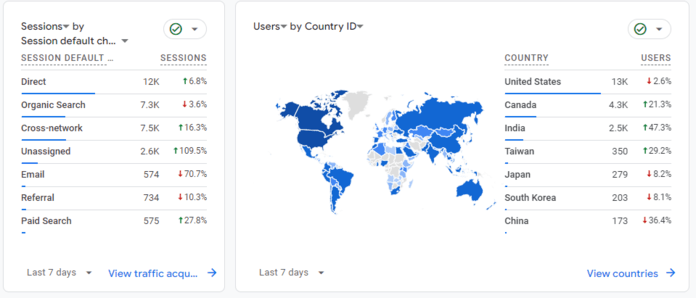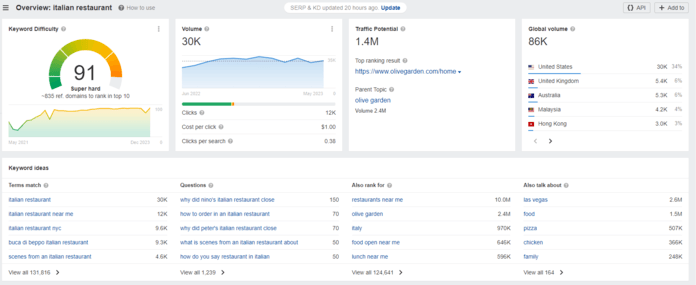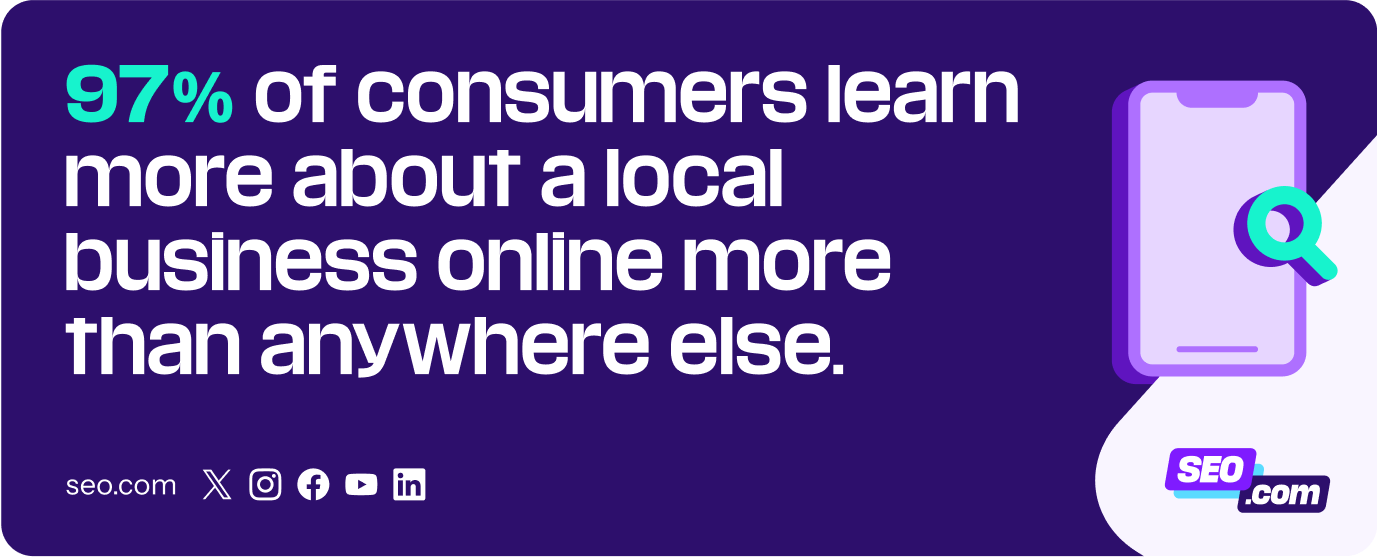With search engine optimization (SEO), your business can attract, nurture, and convert your target audience through search. Getting to that point, though, requires a search engine optimization campaign, which is why we’re breaking down how to create an effective SEO campaign for your site.
What is an SEO campaign?
An SEO campaign is how a business generates, measures, and grows its organic traffic from search. Typically, SEO campaigns include setting goals, researching keywords, creating content, acquiring links, and measuring results.
How to create an effective SEO campaign
Learn how to create an effective SEO campaign for your business with these steps in our SEO checklist:
- Outline your goals
- Assign your roles
- Set up your tech
- Research your keywords
- Create your content
- Grow your backlinks
- Measure your performance
1. Outline your goals
Every marketing campaign needs to measure its performance, which is why SEO campaigns begin with setting goals. Like any digital marketing campaign, you’ll want to create specific, measurable, actionable, realistic, and timely goals (SMART).
Some of our favorite tips for brainstorming goals for search engine optimization campaigns include:
- Speak with your stakeholders to understand their SEO expectations
- Analyze your site’s existing SEO to understand your site’s strengths, SEO issues, and more
- Review your tech stack to understand what you can measure
- Audit your online competitors like with Semrush or SpyFu to see where they’re leading or failing in search
Once you’ve outlined your campaign goals, you can proceed with the next step.
2. Assign your roles
Next, determine who will work on what. Some typical roles in SEO marketing campaigns include:
- SEO for off-page, on-page, and technical SEO optimizations.
- Copywriter for writing SEO content.
- Web designer for creating content visuals.
- Web developer for providing development assistance, if needed.
Your organization’s roles may vary. For example, instead of a single SEO, you might have specialized SEOs, like a technical SEO services provider, another for off-page SEO, and someone else for on-page SEO. The goal here is to outline who is responsible for bringing your campaign to life.
3. Set up your tech
If you haven’t already, you’ll want to set up your SEO campaign’s tech, like:

The above are industry standards for SEO, but that doesn’t mean your team can’t use other toolkits.
Besides Google Search Console and Google Analytics 4, you’ll likely want some SEO software for your campaign. While you can use free tools like Google Trends, you’ll often find value in paid SEO kits like Ahrefs or Semrush when researching keywords, evaluating competitors, and more.
4. Research your keywords
Free keyword generator
Oops! You are too eager for information and you’ve reached your daily amount of requests. Feel free to check it tomorrow.
Mmm… an error occurred during processing. Please refresh the page and try again.
We are working to fix it right now. Please, try again in a few minutes.
Access denied: Your session token is invalid or missing. Please refresh the page to continue.

Keyword ideas for “”
| Keyword | Cost per Click | Keyword Difficulty | Search Volume |
Next, your business can begin keyword research to help your site:
- Grow its qualified traffic
- Reach its target audience
- Increase its revenue
From Semrush to Ahrefs alternatives, you have choices when it comes to keyword research tools.

These platforms vary in price, with Keywords Everywhere offering the most cost-effective option for small businesses looking for just a keyword research tool.
Tired of Semrush?
Find an alternative with our comparison of Semrush vs. Ubersuggest
No matter your choice, these are our tips for choosing effective keywords for your SEO campaign:
- Focus on keywords relevant to your business and its target audience
- Look for keywords with a higher search volume and lower keyword competitiveness
- Evaluate every keyword’s search intent before adding it to your keyword list
You’ll also want to ensure your keywords support your search campaign’s goals.
5. Create your content
With your keywords selected, you can start creating your content. Content is vital to a successful SEO campaign. But, why is content important for SEO? Content helps users discover and visit your site when they search for information related to your business online.
Here are some tips:
- Add your target keyword to your title tag and meta description
- Use your target and related keywords throughout your content
- Write your content with a user- vs. SEO-first perspective
If you plan to include content visuals, you’ll want to work with your web designer (or a free tool like Canva) to create your graphics. Alternatively, add screenshots to your content to demonstrate an example or show readers how to complete a step.
And don’t forget to check your content for any grammar errors. You might be wondering, “Does grammar matter in content marketing?” Yes! Correct grammar sends valuable trust signals to your audience, so be sure to check for and correct any mistakes!
As a final step, have your SEO team member review and optimize the content’s on-page SEO.
6. Grow your backlinks
Whether you’re looking to attract backlinks through your new content or existing, you’ll likely need some dedicated time in your SEO marketing campaign for link building. Link building can take multiple forms, from attracting links passively, through outreach efforts, using the best link building tools or link building services.
For most search engine optimization campaigns, there is an element of both.

Backlinks are hyperlinks from other websites to yours, crucial for SEO as they signal trust and authority to search engines, impacting rankings.
| Statistics | |
| 66% of pages have zero backlinks | Source |
| 41% of marketers view link building as the most difficult part of SEO | Source |
| 26% of pages have fewer than three backlinks | Source |
| $361 is the average price for a backlink | Source |
| View our Link Building Services |
7. Improve your technical SEO
As your site grows its organic rankings, review your SEO audit from Step 1. Look for technical SEO improvements, which can level-up your performance sitewide, that your team can tackle.
For example, can you improve page speed by compressing your images or asking your developer to minify your code? Or, can you add schema markup to URLs to help search engines better understand their context?
To enhance your website’s technical SEO, consider the following essential tips:
- Optimize for mobile: Ensure your website provides a smooth navigation experience for users on smartphones and tablets.
- Use a structured URL Format: A well-organized URL structure enhances comprehension for both users and search engines.
- Implement an XML sitemap: This helps search engines index your pages more effectively, improving visibility.
- Monitor for broken links: Regularly check for and resolve any broken links to enhance the user experience.
- Prioritize technical fundamentals: By focusing on these key aspects, you’ll lay a strong foundation for your website’s success in search engine rankings.
8. Measure your performance
Free domain overview
Oops! You are too eager for information and you’ve reached your daily amount of requests. Feel free to check it tomorrow.
Mmm… an error occurred during processing. Please refresh the page and try again.
We are working to fix it right now. Please, try again in a few minutes.
Access denied: Your session token is invalid or missing. Please refresh the page to continue.

Monthly Traffic data for “” vs “”
Your domain’s traffic
Your competitor’s traffic
“” ranks for keywords that you don’t
| Keyword | URL | ETV |
With the launch of your SEO campaign, you can start measuring your performance.
Personally, we recommend setting up your performance dashboard at the beginning. This approach lets you catch tracking issues or errors early so your team can troubleshoot and fix them before your campaign advances too far.
What you measure will depend on your earlier SEO goals. Some popular metrics include:
- Keyword positions
- Organic traffic
- Organic conversion rates
- Links acquired
- And more

Again, you must focus on the metrics and key performance indicators (KPIs) that best measure your SEO campaign’s strategy goals.
9. (If applicable) Claim your local listings
Does your business have a physical location (like a bakery) or visit users (like a plumber)? Then, claim your local listing via Google Business Profile, Bing Places, and Apple Maps. These listings will give you visibility in localized search results.
(They’ll also give you a link to your website)
As you claim these local listings, remember to update the following:
- Name
- Address
- Phone numbers
Consider adding photos too, as they’ll provider more context about your location.

Local SEO focuses on online optimization to improve local search visibility, helping businesses attract nearby customers searching for products or services.
| Statistics | |
| 97% of consumers learn more about a local business online more than anywhere else | Source |
| 88% of mobile searches for a local business result in a call or visit to the business in 24 hours | Source |
| 76% of users who search on their smartphones for something nearby visit a company within 24 hours | Source |
| 72% of users who did a local search visited within a five-mile range if the business had images of the product they were looking for | Source |
| 56% of local retailers have not claimed their Google Business Profile listing | Source |
| 46% of Google searches relate to finding local information | Source |
| 28% of local searches result in a purchase | Source |
| View our Local SEO Services |
10. Common SEO Mistakes to Avoid
When optimizing your website for search engines, it’s important to steer clear of common pitfalls that can hinder your efforts. Here are some mistakes to avoid:
- Neglecting mobile optimization: Failing to ensure your site is mobile-friendly can lead to a poor user experience and lower rankings, as search engines prioritize mobile usability.
- Ignoring page speed: Slow-loading pages can frustrate users and increase bounce rates. Optimize images, leverage browser caching, and minimize code to improve loading times.
- Overlooking keyword research: Not conducting thorough keyword research can result in targeting the wrong terms. Use tools to identify relevant keywords that your audience is searching for.
- Duplicate content: Having identical or very similar content on multiple pages can confuse search engines and dilute your rankings. Always strive for unique content.
- Poor URL structure: Complicated or unclear URLs can make it difficult for search engines to index your pages. Use simple, descriptive URLs that reflect the content.
- Ignoring analytics: Failing to track your website’s performance can prevent you from understanding what works and what doesn’t. Use analytics tools to monitor traffic and user behavior.
Launch a successful SEO campaign
Congrats, you’re ready to create a successful SEO campaign, and WebFX (the team behind SEO.com) is here! For professional help with developing, implementing, and managing your SEO campaign, consider our professional SEO services!
Got questions? Contact us online to ask!
Let’s Drive Results
Together


Don’t fail your website’s most important test
Get an SEO scorecard of your website for free in less than 30 seconds.
Table of Contents
- What is an SEO Campaign?
- How to Create an Effective SEO Campaign
- 1. Outline Your Goals
- 2. Assign Your Roles
- 3. Set Up Your Tech
- 4. Research Your Keywords
- Tired of Semrush?
- 5. Create Your Content
- 6. Grow Your Backlinks
- 7. Improve Your Technical SEO
- 8. Measure Your Performance
- 9. (If Applicable) Claim Your Local Listings
- 10. Common SEO Mistakes to Avoid
- Launch a Successful SEO Campaign
Don’t fail your website’s most important test
Get an SEO scorecard of your website for free in less than 30 seconds.
What to read next
- Feb 25, 2025
- 7 min. read




